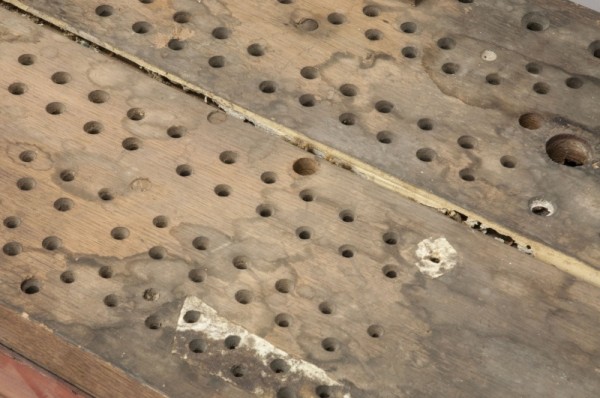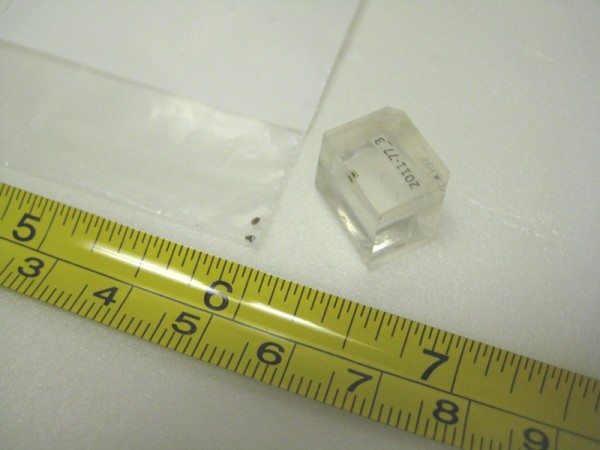A toe board looks like a solid board with slightly funnel-shaped holes for the pipes (see wind-chest diagram), but the boards are anything but solid. …
Beneath the Surface: The Clues in a Paint Sample
Finding "Blow" in the Wind-chest
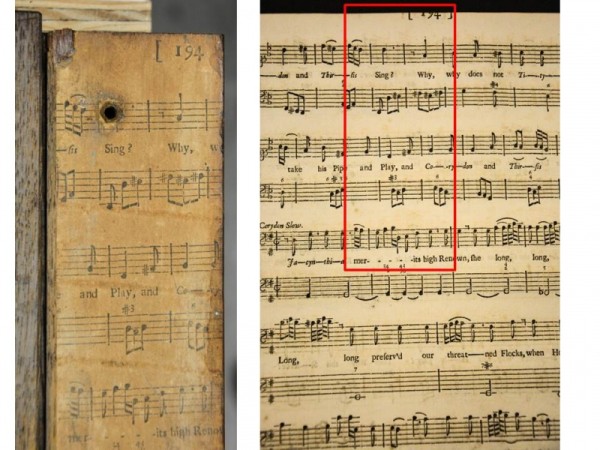
Music Paper was used to prop the toe boards above the sliders to allow the sliders to move
By John Watson
Perhaps it seemed only natural that the original makers of the organ wind-chest chose old printed music to use as paper shims. The music paper was added to build up the thickness of the bearers so they would stand a single thickness of paper higher than the sliders, allowing the sliders to shift without binding under the toe boards (see wind-chest diagram).
I wondered whether the music could have been some old unsold stock from music merchants Longman & Broderip. L&B had recently gone out of business at the time James Longman, Muzio Clementi and their partners started Longman, Clementi & Co., producing this organized piano in their first year (1799).
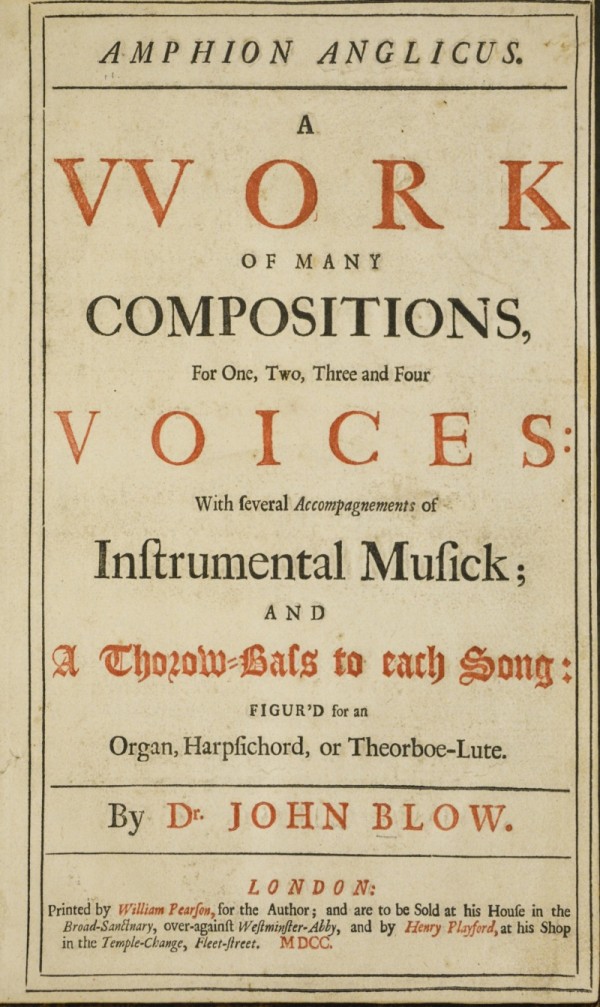
Title page of Amphion Anglicus, the anthology of music published by John Blow in 1700. Colonial Williamsburg Special Collections
Dr. Nikos Pappas came through the lab last week and spotted the music paper glued to the wind-chest. Nikos, a musicologist here in Williamsburg for a research fellowship at our library, made a surprising observation. Nikos pointed out that the music was printed using movable type. That technology for printing music had been replaced by engraving early in the 18th century. The music paper was much earlier than I thought.
Taking into account that some of the paper fragments had page numbers up to 204, Nikos knew that very few books of music in that early period had so many pages. He had already spotted one of them in the special collections of Colonial Williamsburg’s John D. Rockefeller Jr. Library. It was Amphion Anglicus, an anthology of music composed and published by the celebrated early English composer John Blow in the year 1700.
The next day, I made an appointment to see our original copy of Amphion Anglicus. With a photograph of one of the paper shims bearing the page number 199, I asked Doug Mayo in the library’s Special Collections to turn to page 199.
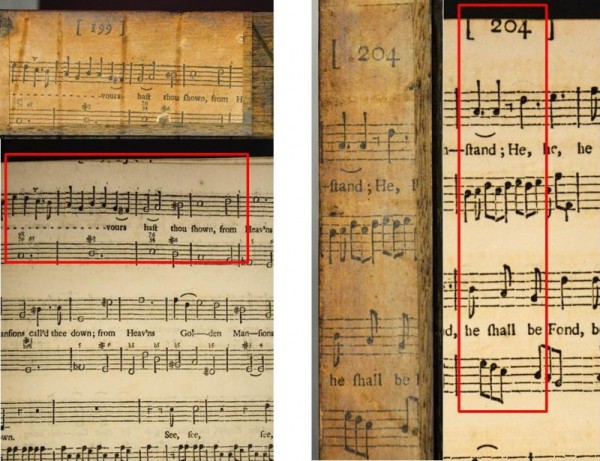
Two of the paper shims from the wind-chest (darker) next to the corresponding pages in the original 1700 publication. Colonial Williamsburg Special Collections
Voila! It was a perfect match.
The workmen had cut up what was already a 99-year-old book of music, composed and published by John Blow one year after Blow’s appointment as composer to the Chapel Royal.
Today, of course, no one would think of cutting up a first edition of John Blow’s Amphion Anglicus. Undoubtedly, Blow is venerated among today’s early-music enthusiasts more than he was in 1799. Perhaps the paper was the right thickness for the shims. Or perhaps the organbuilder just had a sense of humor, putting “Blow” in the wind-chest.
In the next post, we’ll look take a major step in the restorative conservation of the wind-chest.
Conservation of the Tucker organized piano is made possible by a gift in memory of N. Beverley Tucker, Jr.
The Bed of Red Lead
Folding camp bed (1954-381) in the CWF collection. The bed has its original sacking which was the subject of this analysis.
Some analytical projects yield unexpected results. This week, I thought I would share with you one of those cases.
In our collection, we have a folding camp bed that dates to c.1770-1815, and includes the frame with its original sacking.
…
Beneath the Surface: The Return of the Green Lantern
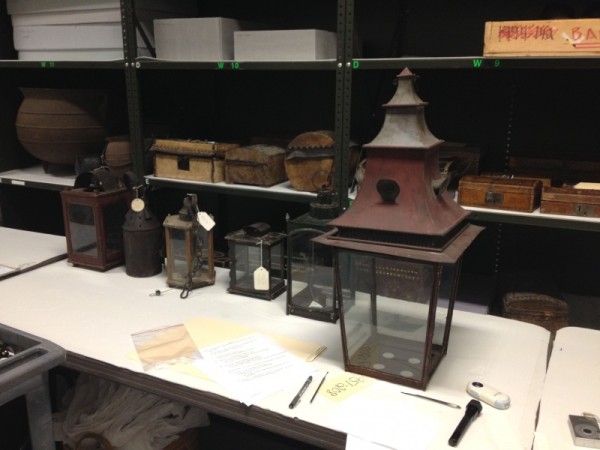
Lanterns from the CWF collection awaiting analysis
Hello and welcome to the first post of “Beneath the Surface”, the blog that keeps you up to date on the latest activities at Colonial Williamsburg’s Materials Analysis Laboratory, where the 18th century meets modern-day science. Here, we use sophisticated analytical instruments to better understand the art and artifacts that make up our varied collection….
The George Washington Seal
An object slight in stature but mighty in meaning has Colonial Williamsburg historians excited. Jokingly referred to as “boy bling” by Metals Curator Janine Skerry, this small watch seal is as exquisite as it is rare.
…
The Wind-Chest During Treatment
With chalk marking areas of detachment, fine holes just large enough to insert a hypodermic needle are drilled into the thin table board.
By John Watson
Two centuries of dust accumulation and the detritus of a few generations of mice had left the wind-chest congested with debris….
The Wind-Chest Before Treatment
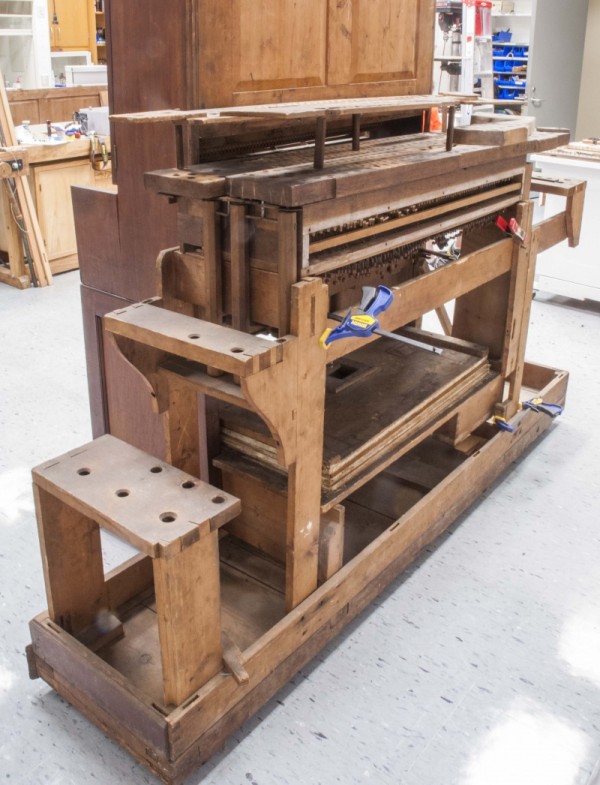
The wind-chest sits on top of the chassis just behind the upright grand piano. The organ’s pipes and outer casework are removed.
By John Watson
We’re back after some re-organization of the blog….
Market House Field Work
Market House, Market Drayton, Shropshire, England, 1824. This gabled, open-sided market house illustrates a relatively refined but small market structure, treated as a temple. Note how the center pair of columns in the gable end are more widely spaced than the others, suggesting that the principal axis of circulation for shoppers was down the center of the building, with market stalls on either side. This is the arrangement adopted for the Williamsburg Market House (photo: Photograph by Jeffrey E. Klee, CWF).
In two early Reconstruction Blog posts, architectural historian Carl Lounsbury described the market day scene: what you might see, hear, and smell, and how markets functioned in 18th century towns. Architectural conservator Matt Webster then walked us through the process of calculating quantities, and producing (by hand) the materials needed to reconstruct Williamsburg’s Market House. But how did we get from “there” to “here”? In this post, architectural historian Jeff Klee describes the architectural field work that informed working drawings for Williamsburg’s 18th century Market House.
…
Preserving the Link to Jamestown Island’s Earliest Days
Restoration mason Kevin Nieto works in a tight space between tower and church.
Historic buildings are often resplendent against the backdrop of a picture-perfect day. They let us leave the 21st-century for a momentary glimpse of life long ago. Yet the hard work required to create those snapshots isn’t always blue skies and sunshine. One case in point now stands at Historic Jamestowne, cradle of modern American culture.
…
